Jolfa Neighborhood: The Armenian Quarter of Isfahan
Jolfa is one of the most beautiful and historic neighborhoods in Isfahan. Unlike traditional Iranian streets, Jolfa's distinct charm resembles the streets of Europe, with its elegant cobblestones, unique house architecture, and small fountains lining the streets, captivating every passerby.
Jolfa is also known as the Armenian Quarters of Isfahan. Stepping into the neighborhood feels like stepping into another world, transporting you to a European neighborhood from 400 years ago.
Built by Armenian settlers that was relocated to Isfahan by Shah Abbas I in 1605 CE. These Armenian settlers, primarily merchants, continued their trade in Isfahan and left a significant mark on the city by constructing remarkable buildings under the patronage of wealthy figures like Khwaja Avadik and Khwaja Nazar.
Jolfa is renowned for its historical and religious landmarks, particularly the Amenaprkich Church (also known as Vank) and the Bedkhem Church. The area is also home to the Khachatur Kesaratsi Museum, which preserves over 1,200 Armenian artifacts.
In this blog, we’ll take you on a journey through the enchanting streets of Jolfa and uncover its fascinating history and attractions.
History of Jolfa Neighborhood in Isfahan
In 999 AH (1590 AD), a treaty was signed between Shah Abbas I of the Safavid dynasty and Sultan Murad III of the Ottoman Empire, which resulted in the loss of several regions, including Tabriz, Armenia, Georgia, Shaki, and Karabakh, to the Ottomans.

However, in 1013 AH (1604 AD), conflict reignited between the two empires. Jolfa, an Armenian city located near the border of Nakhchivan in Azerbaijan, found itself caught in the middle of these military campaigns.
Faced with military setbacks, Shah Abbas ordered a strategic retreat and the relocation of the local Armenian population deeper into Iranian territory to protect them from Ottoman advances.
During the winter, many Armenians from Jolfa and other regions of Armenia were relocated to areas such as Tarom, Khalkhal, Ahar, and Meshginshahr. After enduring a harsh winter, they reached Isfahan in the spring, where they were resettled on the outskirts of the city. Here, they established New Jolfa (Jolfa-ye Esfahan), a new neighborhood reminiscent of their former home.

In their new settlement, the Armenians built beautiful homes, churches, streets, and water channels, bringing the charm of Old Jolfa to their new community. Shah Abbas, in an effort to honor the Armenians, named the new neighborhood "Jolfa" and granted them lands along the Zayandeh River.
New Jolfa became a vibrant Christian community in Isfahan, home to Orthodox, Protestant, and Catholic Armenians. Over time, Armenians from other parts of Isfahan also moved to this neighborhood, giving it a distinctly Christian character.
Architecture of Jolfa Neighborhood in Isfahan

The architecture of the Jolfa neighborhood in Isfahan stands out distinctly from the rest of the city. When this historic area was first established, it consisted of several smaller districts, including Bazar-e Bozorg (Great Square), Bazar-e Kuchak (Small Square), Hakopjan Crossroads, and Qaragol.
The old buildings of Jolfa are arranged in a unique manner, with clean, cobblestone streets, tall clocks, cafes, and numerous churches, all of which amaze visitors with their charm.

The Armenian residents of Jolfa skillfully combined elements of Iranian, Islamic, and Armenian architecture. Using local materials such as mud bricks and clay, they built striking structures that are a harmonious blend of styles. This architectural fusion is one of the key attractions of the neighborhood, adding a distinct cultural and aesthetic appeal.
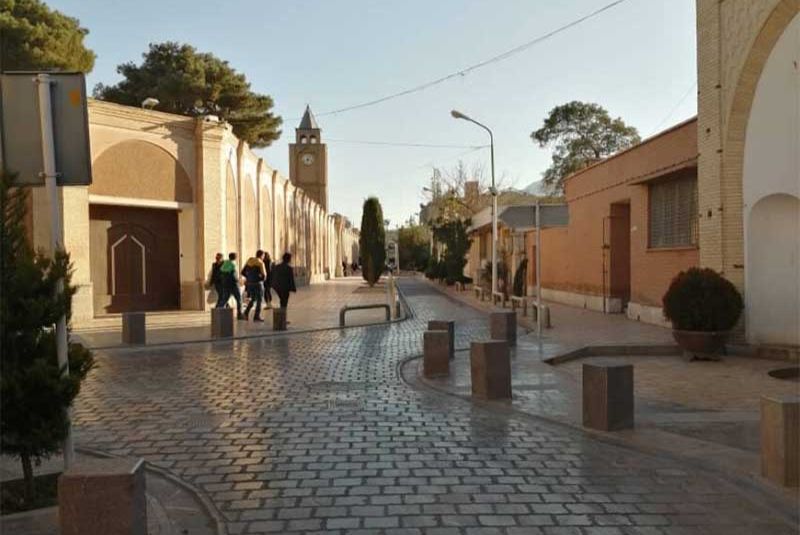
In addition to the remarkable buildings, Jolfa is home to numerous statues, further enriching its artistic landscape. One of the most prominent is the statue of the Virgin Mary, depicted holding a brass water vessel, which shines beautifully among the other sculptures. Almost every fountain and water feature in Jolfa is adorned with a stunning statue, enhancing the serene and picturesque atmosphere of the area.
Jolfa's unique blend of architecture and art creates an exceptional experience, making it a fascinating destination for visitors who appreciate history, culture, and design.
Tourist Attractions in Jolfa Neighborhood
The Armenian Quarters of Isfahan is one of the city's most beautiful and culturally rich areas. Jolfa's residents have contributed immensely to the development of the city's culture and art, introducing modern schools, the first printing press, classic music, and various European influences. Here are some of the top tourist attractions you must see when visiting the Jolfa neighborhood in Isfahan.
Vank Cathedral
One of the most famous landmarks in Jolfa is Vank Cathedral, also known as the Holy Savior Cathedral. Built during the reign of Shah Abbas II, this stunning church was inspired by St. Stepanos Church in Old Jolfa, Azerbaijan.
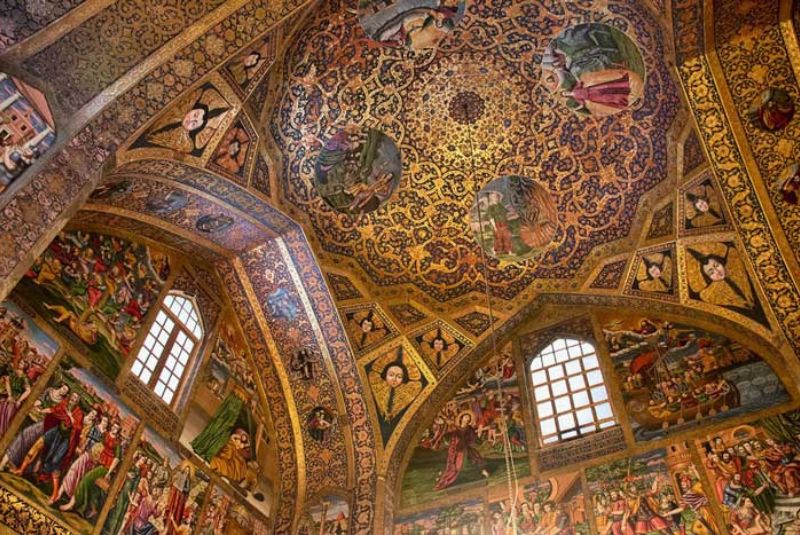
The golden ceilings, dome paintings, and historical frescoes are awe-inspiring, offering visitors a glimpse into the grandeur of Armenian Christian art. The oil paintings and gold-leafed murals depicting biblical scenes are remarkable, with influences from Italian Renaissance art evident in the intricate details.
St. Bethlehem Church (Betlehem Church)
Located near Jolfa Square, St. Bethlehem Church is another architectural gem. Built during the Safavid era by Khwaja Petros, a prominent merchant, the church showcases European influences in its design, including the use of marble and stunning tilework.

It also features the largest dome made from brick and clay in the region. Many of Khwaja Petros's family members are buried here, and the church remains an important spiritual center for the local Armenian community.
St. Mary Church
Constructed by the Armenian merchant Awdik during the reign of Shah Abbas I, St. Mary Church is another masterpiece of religious art in Jolfa. The dome and ceilings are adorned with incredible paintings and tilework.
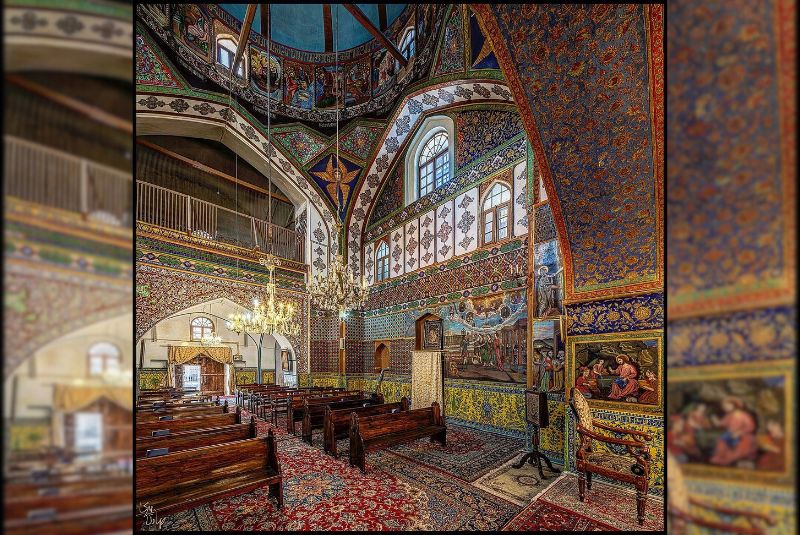
Located in the heart of Jolfa Square, this historical church reflects the rich artistic traditions of the Armenian community in Isfahan.
St. Sarkis Church
St. Sarkis Church is a unique two-domed structure, making it stand out from other churches in Jolfa. Each dome features eight windows, allowing natural light to flood the interior.
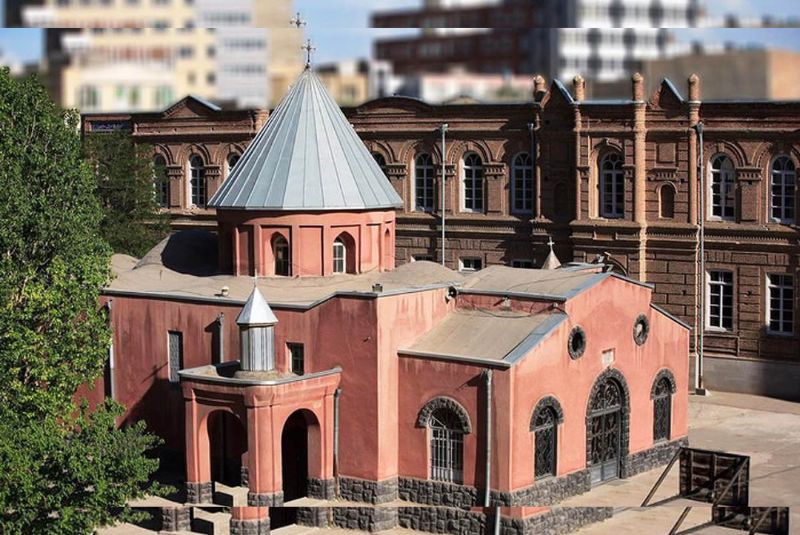
Though the church has been extensively restored over the years, its history dates back to the Safavid era. While much of the original artwork has faded, some of the ceiling paintings remain intact, showcasing the church’s artistic heritage.
St. George Church (St. Gevork Church)
St. George Church is one of the oldest churches in Jolfa, built to serve the religious needs of the early Armenian settlers in Isfahan. Located on Hakim Nezami Street, this church is simple in design compared to others in the neighborhood, with minimal decorations and only one prominent tiled image of the Virgin Mary and Christ. Despite its simplicity, St. George holds a special place in the community's religious history.
Jolfa's Charming Cafes
One of the most delightful aspects of Jolfa is its vibrant café culture. Strolling through the narrow alleys, you will encounter many charming cafes with European-style décor and streets adorned with flowerpots.

The aroma of freshly brewed coffee fills the air, enticing passersby to step inside for a break. Some of the most popular cafes include Café Hermès, Café Romance, Café Dalon, and Sharbath House Firouz. These spots are perfect for relaxing after exploring the historic churches and enjoying the lively atmosphere of the neighborhood.
Jolfa's Artistic Streets
Jolfa is also home to several famous streets, such as Khaghani Street, known for its art galleries and fashionable boutiques. Sangtarashha Street, a fully cobblestone-paved street, is another highlight, offering a tranquil and safe spot where many local Armenians gather.
These streets provide a glimpse into the vibrant cultural scene of Jolfa and are perfect for leisurely walks.
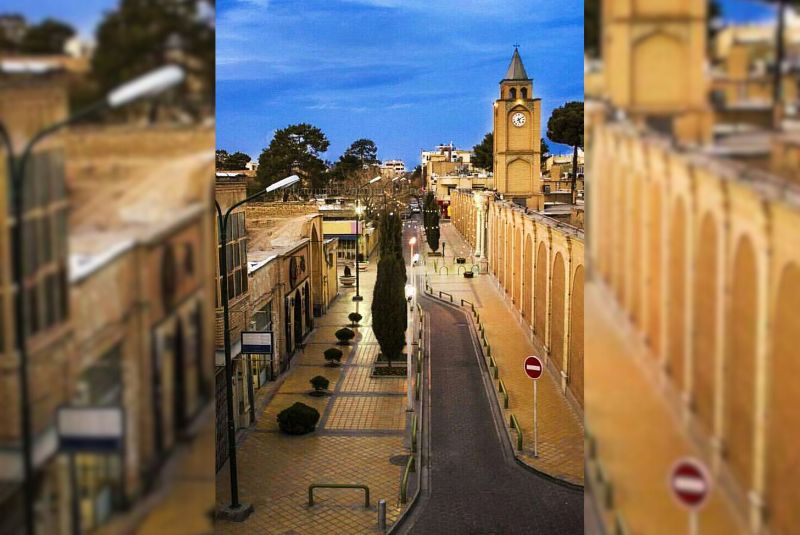
Jolfa Neighborhood During Christmas
Christmas in the Jolfa neighborhood of Isfahan is an extraordinary experience filled with festive cheer. During the holiday season, the entire area transforms into a vibrant celebration of Christmas. Shops and stores throughout the neighborhood sell Christmas decorations, and the streets are filled with joy and excitement.

The most notable celebrations take place at the Vank Cathedral and the Bethlehem Church, but the entire neighborhood is immersed in the joy of Christmas and the New Year, commemorating the birth of Jesus Christ. Religious music fills the air, accompanied by the ringing of church bells, creating an atmosphere of celebration that is truly indescribable.

The iconic Christmas tree, beautifully decorated with lights and colorful fabrics, is a symbol that graces the streets of Jolfa during this time. At night, the entire neighborhood glows with festive lights, making it a magical place to visit during the Christmas season.
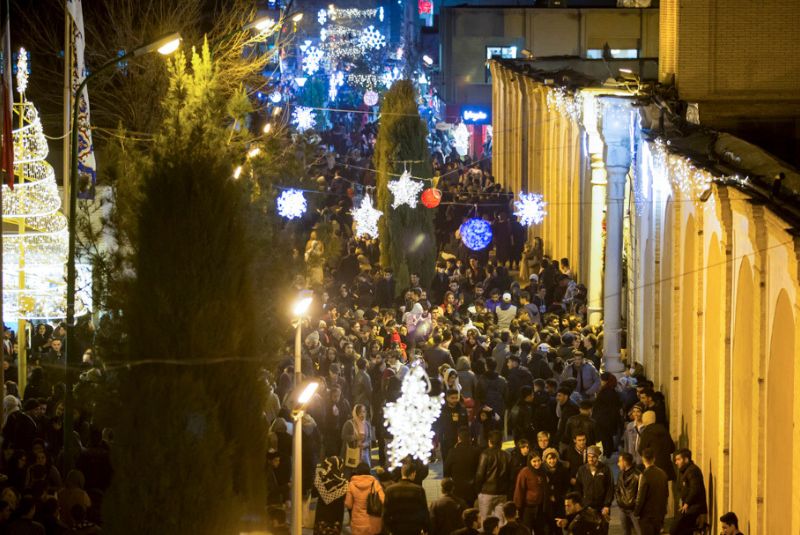
Another symbol of Christmas, Santa Claus, is also prominently displayed alongside Christmas trees in shop windows. Local residents prepare a variety of delicious foods and sweets for Christmas, with popular dishes including rice, fish, and different types of “kuku,” especially “kuku sabzi,” a common herb-based dish enjoyed during the holiday festivities.
Jolfa Neighborhood Location and Access
Jolfa is one of the most famous and scenic neighborhoods in Isfahan, located between Jolfa Hotel, Jolfa Square, and Vank Cathedral. This area is known for being one of the busiest parts of the city and is historically the Armenian quarter of Isfahan.
Upon entering Jolfa, visitors immediately notice the distinct charm and character of the neighborhood. The cobblestone streets, tall clock towers, beautiful churches, and quaint cafes reflect a different world, giving it a unique identity within Isfahan.
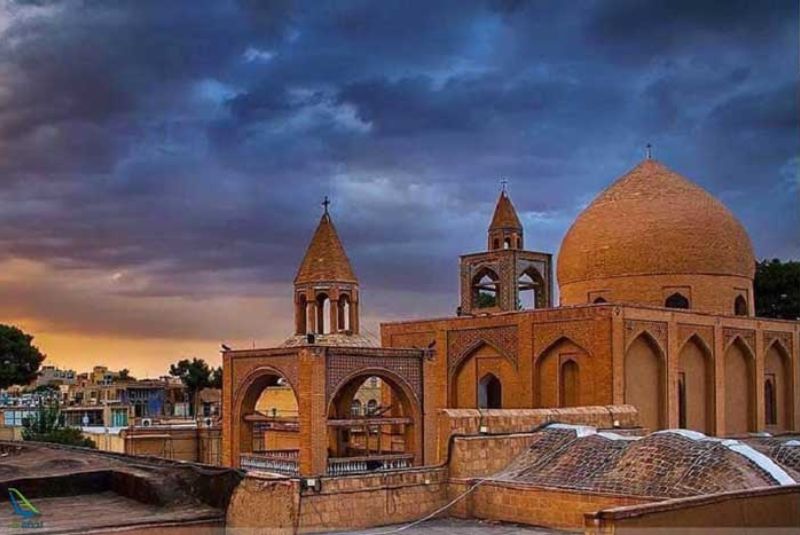
For those who want to experience European or Western lifestyles in Iran, Jolfa offers a captivating glimpse, with cozy cafes playing Western music and wooden chairs set close together, making it the perfect spot to enjoy a cup of coffee or a refreshing drink.
You'll also find fountains adorned with statues, including a notable one of the Virgin Mary holding a brass bowl of water. The calm atmosphere of Jolfa, with its pedestrian-friendly streets, adds to the area's appeal.
How to Get to Jolfa Neighborhood
Reaching Jolfa is quite simple, as it's one of the most well-known parts of Isfahan. If you take a taxi, drivers will easily find the way without any trouble. For those using public transportation, you should board buses or BRT lines that pass through Tohid Street and Khaqani Street to reach Jolfa.
Best time to Visit Jolfa Neighborhood in Isfahan

The best time to visit the Jolfa neighborhood in Isfahan is during the cooler months of autumn and winter, especially around Christmas. From late November to early January, the streets are beautifully decorated, and the festive atmosphere adds a magical charm to the area. This period is ideal for experiencing the vibrant cultural celebrations, including Christmas festivities at Vank Cathedral and Bethlehem Church.
The mild weather makes walking through Jolfa's picturesque cobblestone streets pleasant, while the unique architecture and cozy cafés offer a perfect backdrop for exploration and relaxation during this time of year.
Tips for Visiting Jolfa Neighborhood
- Plan Your Visit: during the cooler months, particularly around Christmas, to enjoy the festive decorations and activities.
- Explore the Churches: Don’t miss Vank Cathedral and Bethlehem Church, which showcase stunning architecture and art.
- Taste Local Cuisine: Try traditional dishes like rice, fish, and kuku sabzi at local restaurants.
- Stroll the Streets: Wander through the picturesque cobblestone streets to experience the neighborhood’s unique charm.
- Visit Cafés: Enjoy a break at cozy cafés while savoring coffee or traditional Iranian sweets.
- Photography: Bring your camera; the blend of architecture and festive decor makes for great photos.
- Shop for Souvenirs: Explore local shops for unique Armenian handicrafts.
- Transportation: Use taxis for easy access, as most drivers know the area well.
- Respect Traditions: Be mindful of local customs, especially during religious celebrations.
Bottom Line
The Jolfa neighborhood in Isfahan stands out as a beautiful fusion of history and culture. Established in the early 17th century by Armenian settlers relocated by Shah Abbas I, it boasts charming cobblestone streets and unique architecture reminiscent of European towns.
The Armenian Quarters of Isfahan is renowned for its stunning churches, including the Vank Cathedral and Bethlehem Church, which showcase exquisite Armenian art and design. During the Christmas season, Jolfa transforms into a festive wonderland, with decorations adorning shops and lively celebrations filling the streets.
Visitors can enjoy charming cobblestone streets lined with cozy cafés and shops selling unique souvenirs. With easy access via taxis and a welcoming atmosphere, Jolfa provides a unique glimpse into a rich cultural heritage.
Whether you're exploring during Christmas or any other time of year, Jolfa promises an unforgettable experience filled with warmth and joy, making it a must-visit destination for anyone traveling to the city. Discover the enchanting beauty and vibrant spirit of Jolfa on your next trip to Isfahan!
Share your story!
Comment below and let us know about your Experience.
Your story inspires others!


Comment
Leave a Comment